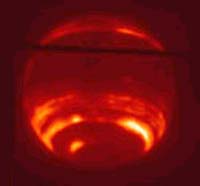 Keck Snaps Neptune's Icy Atmosphere
Keck Snaps Neptune's Icy Atmosphere

Image of planet Neptune taken using the new adaptive optics system at the 10-meter diameter Keck II Telescope on the Mauna Kea volcano in Hawaii. The image uses infrared light with a wavelength of 2 micro-meters to outline the planet in reflected sunlight. The bright bands are haze layers in Neptune's upper atmosphere. By compensating for the blurring effects of turbulence in the earth's atmosphere, adaptive optics has shown much more detail in teh haze bands than has been previously observed from earth-bound telescopes. The dark stripe is a very narrow slit through which light was directed onto a spectrograph in order to characterize the chemical composition of Neptune's atmosphere and the heights of the haze layers. These images were obtained on June 17th. (CREDIT: Imke de Pater/UC Berkeley) |
Mauna Kea - Oct. 25, 2000
Astronomers observing with the adaptive optics instrument on the Keck II Telescope have obtained the best pictures yet of the planet Neptune, showing an upper atmosphere rich with moving features such as vortices, waves and narrowly spaced bands of clouds similar to those present around Jupiter.
The team - which included astronomers from the University of California, Berkeley; Lawrence Livermore National Laboratory (LLNL); the California Institute of Technology, or Caltech; and UCLA - presented the near-infrared images of the giant ice planet today (OCT. 25, 2000) at the American Astronomical Society?s Division of Planetary Sciences meeting in Pasadena, Cal.
The team captured the Neptune images on five nights of observing on Keck II between June 8 and 28 of this year. They had hoped to track characteristics of very bright features previously seen on the planet, but the detail in the images were beyond their expectations.
"We've never seen the detail we see now," said team leader Imke de Pater, a professor of astronomy and of earth and planetary science at UC Berkeley. "This shows us how much structure there is in the planet's atmosphere, how dynamic it is - as dynamic as Jupiter."
The team, which collaborates through the National Science Foundation's Center for Adaptive Optics at UC-Santa Cruz, consisted of UC-Berkeley graduate students Shuleen Chau Martin and Henry Roe, and LLNL physicists Claire Max, Bruce Macintosh and Seran Gibbard.
The team also is presenting new near infrared pictures of the planet Uranus that mark the first ground-based detection of the faint rings around that planet.

Related Links
Keck Observatory
SpaceDaily
Search SpaceDaily
Subscribe To SpaceDaily Express
 Stephan's Quintet - A Mammoth Cosmic Collision
Stephan's Quintet - A Mammoth Cosmic Collision
 Garching - Oct. 25, 2000
Garching - Oct. 25, 2000
A spectacular new image from the NASA/ESA Hubble Space Telescope of the group of galaxies called Stephan's Quintet provides a detailed view of one of the most exciting star forming regions in the local universe.
---------------------------------------------------------
New from Telescopes.com!
It's new. And it's downright terrific!
Celestron's CPC Schmidt-Cassegrain telescope is the
scope you've been waiting for! It offers new alignment
technology, advanced engineering, and bold new design at a
new, low price!
In fact, Celestron's Professional Computerized (CPC) scope
with revolutionary SkyAlign Alignment Technology redefines
everything that amateur astronomers are looking for. It offers quick and simple alignment, GPS technology, unsurpassed optical quality, ease of use, advanced ergonomics, enhanced computerization and, most important, affordability.
Want to view M-31 tonight? One button takes you there!
Shop for telescopes online at Telescopes.com! today!
------------------------------------------------------------
|
 |
|



| The content herein, unless otherwise known to be public domain, are Copyright 1995-2006 - SpaceDaily.AFP and UPI Wire Stories are copyright Agence France-Presse and United Press International. ESA PortalReports are copyright European Space Agency. All NASA sourced material is public domain. Additionalcopyrights may apply in whole or part to other bona fide parties. Advertising does not imply endorsement,agreement or approval of any opinions, statements or information provided by SpaceDaily on any Web page published or hosted by SpaceDaily. Privacy Statement |
|
